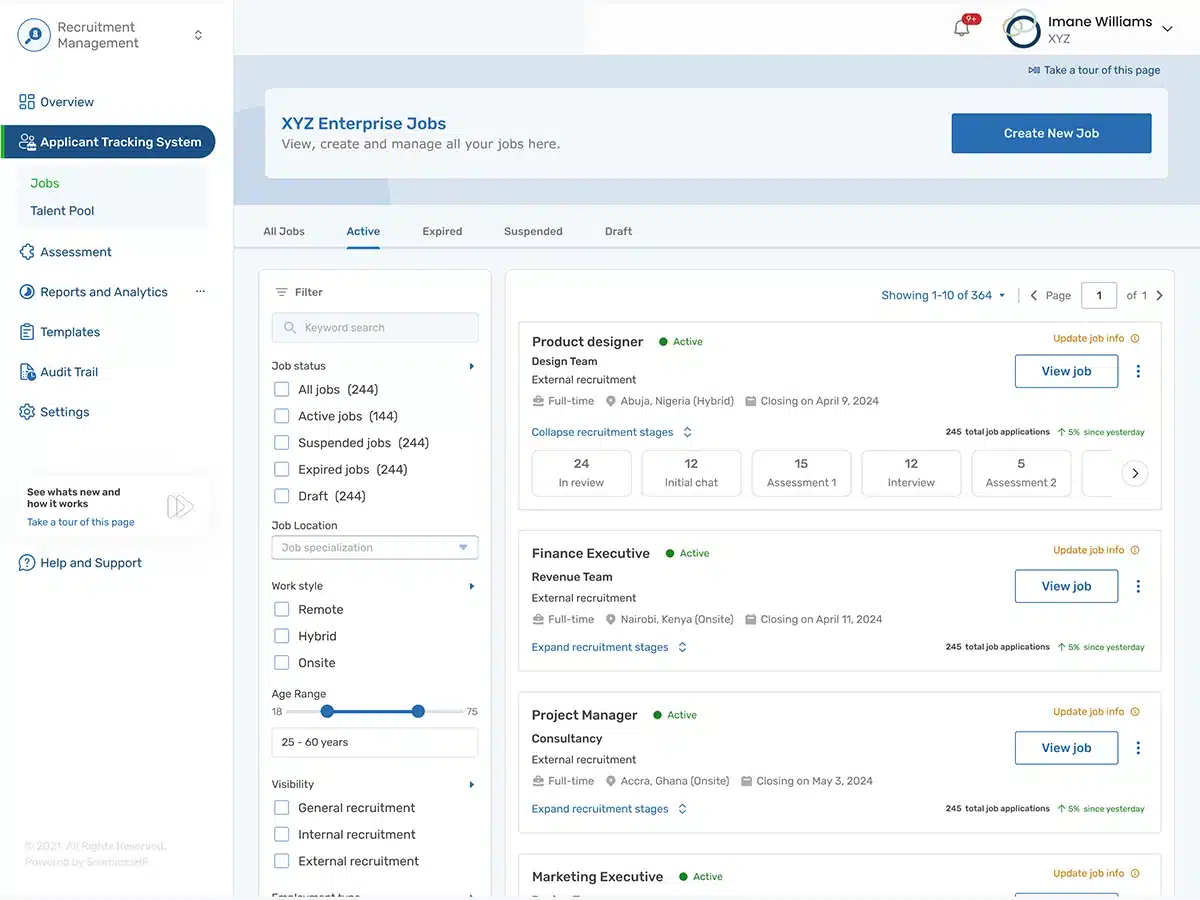In today’s competitive job market, finding the right talent quickly and efficiently is more important than ever. For employers, recruiters, and leaders, an Applicant Tracking System (ATS) is an invaluable tool that streamlines the hiring process, helping organisations attract, screen, and hire the best candidates.
But what exactly is an Applicant Tracking System (ATS), and how can it benefit your business? This comprehensive guide will walk you through everything you need to know about Applicant Tracking Systems, from the basics to best practices.
What is an Applicant Tracking System (ATS)?
An Applicant Tracking System (ATS) is software designed to manage the recruitment process from start to finish. An applicant tracking system (ATS) is used by human resource departments to process the overwhelming number of applications they receive for job openings.

Specifically, an ATS software automates and simplifies tasks such as posting job openings, collecting resumes, screening candidates, scheduling interviews, and tracking the entire hiring process.
How Does an Applicant Tracking System Work?
An Applicant Tracking System (ATS) works by automating and managing various stages of the recruitment process. Here’s a breakdown of the 5 steps of how an ATS typically functions:
1. Job Posting and Distribution: The process begins when a recruiter or hiring manager creates a job posting within the ATS. This includes details such as job title, description, qualifications, and any other requirements.
Once the job posting is created, the ATS allows you to distribute it across multiple job boards, company websites, and social media platforms simultaneously. This ensures broad visibility and attracts a diverse pool of candidates.
2. Resume Filtering Based on Keywords: When candidates apply for the job through various platforms and their resumes are automatically collected by an ATS. The ATS uses algorithms to parse resumes, extracting key information such as work experience, education, skills, and contact details. This data is then organised into a standardised format for easy comparison.
The ATS then screens resumes based on specific keywords and criteria set by the recruiter. This could include required skills, years of experience, education level, and more.
After screening, the ATS ranks candidates according to how well they match the job requirements. Those who best fit the criteria are highlighted for further review, making it easier for recruiters to focus on the most qualified applicants.
3. Candidate Management and Interview Scheduling: Each candidate’s information is stored in a profile within an ATS, including their resume, cover letter, application details, and any notes from recruiters. An ATS allows for automated and manual communication with candidates. Hiring managers can send personalised emails, schedule interviews, and update candidates on their application status directly through the system.
For interview, the ATS is often integrated with calendar systems like Google Calendar or Outlook to facilitate interview scheduling. Recruiters can propose interview times, send invites to candidates and interviewers, and manage schedules all from within the ATS. The system can send automated reminders to candidates and interviewers to ensure everyone is prepared and on time for interviews.
4. Collaboration and Decision-Making Management: An applicant tracking system enables multiple team members to access and review candidate profiles, share notes, and provide feedback within the system. This collaborative approach ensures that everyone involved in the hiring process has the necessary information to make informed decisions.
Once interviews are completed, the ATS software helps in finalising the selection process by compiling feedback and scores from the hiring team. This data-driven approach assists in making a well-informed hiring decision.
Interestingly, after a candidate is selected, the ATS can generate and send offer letters. Some systems even allow for the digital signing of offer letters, streamlining the process further.
5. Onboarding Integration and Analytics: Many ATS platforms integrate with onboarding tools, allowing for a seamless transition from candidate to employee. This include sending new hire forms, setting up IT access, and assigning onboarding tasks. An applicant tracking system can track the completion of onboarding tasks, ensuring that the new hire is properly set up and ready to start their new role.
Additionally, throughout the recruitment process, the ATS collects and stores data on various metrics, such as the number of applicants, time-to-hire, cost-per-hire, and more. The ATS provides detailed reports and analytics that help recruiters understand the effectiveness of their hiring process. These insights can be used to make improvements, identify bottlenecks, and optimise future recruitment efforts.
Is an Applicant Tracking System (ATS) the Same as Candidate Relationship Management (CRM)?
No, an Applicant Tracking System (ATS) is not the same as Candidate Relationship Management (CRM), although they are related and often work together in the recruitment process. Here’s how they differ:
Applicant Tracking System (ATS)
- An ATS is primarily focused on managing the recruitment process from start to finish.
- An ATS is typically used to manage active candidates who have applied for open positions. It tracks their progress through the hiring pipeline and helps recruiters select the best candidate for the job.
- Key features of an ATS include job posting distribution, resume parsing, candidate ranking, interview coordination, and compliance management.
Candidate Relationship Management (CRM)
- A CRM in the context of recruitment is focused on building and maintaining relationships with potential candidates, including those who may not be actively applying for a job at the moment.
- A Candidate Relationship Management (CRM) is used to manage passive candidates—those who may not be actively seeking a job but are open to opportunities.
- Key features of a recruitment CRM include talent pooling, nurturing campaigns, personalised communication, and tracking candidate engagement over time. It helps recruiters keep a long-term view of talent acquisition, focusing on relationship-building rather than immediate hiring needs.
Here’s how an Applicant Tracking System and a Candidate Relationship Management System work together:
- The ATS and CRM systems are integrated to create a seamless recruitment experience. While the ATS manages the immediate, tactical needs of hiring, the CRM manages the strategic, long-term relationships with potential candidates.
- An employer or a hiring manager might use the CRM to engage with potential candidates, sending them relevant content and keeping them informed about the company. When a suitable position opens up, these candidates are then moved into the ATS for the formal application and hiring process.
While an ATS and CRM serve different purposes, they complement each other in the recruitment process. The ATS focuses on the efficiency of managing active candidates through the hiring stages, while the CRM is about building and nurturing relationships with potential candidates over the long term.
ATS System for Recruitment: Impact on Business Growth
An ATS does not only enhances the quality of hires but also accelerates the hiring process, directly contributing to business expansion and success. Below are the key impacts an applicant tracking system makes.
1. Faster Time-to-Hire: An ATS speeds up the recruitment process by automating tasks such as resume screening and interview scheduling, allowing businesses to fill positions more quickly.
2. Reduced Recruitment Costs: An ATS minimises the resources spent on recruitment. By reducing the time-to-hire and improving the efficiency of the process, businesses save on costs related to prolonged vacancies and inefficient hiring practices.
3. Enhanced Employee Retention: With more effective screening and selection processes, an ATS helps ensure that new hires are a good fit for the company culture and job role. This leads to higher employee satisfaction and retention rates, which reduces turnover costs and contributes to a more stable, productive workforce.
4. Supporting Business Expansion: As a company grows, its recruitment needs increase. An ATS can easily scale to handle higher volumes of applications, enabling businesses to expand their teams efficiently and meet growing demands.
5. Strengthened Employer Brand: By providing a smooth and professional application process, an ATS helps build a positive employer brand. A strong reputation as a desirable place to work attracts top talent, which is crucial for sustaining business growth.
Here’s Why SeamlessHR ATS is the Best Recruitment System for Your Business
With SeamlessHR recruitment management software – SeamlessHiring, you have an efficient system for hiring.

With powerful new recruiter Applicant Tracking System (ATS online), you can search, sort, and select the best candidates using all the filters and criteria you need. Search results come even faster, so you can spend less time sifting through resumes.
SeamlessHR recruitment management system integrates with Microsoft and Google to makes your interview scheduling so much easier! There’s no need to go outside the app to schedule interviews, and now, you won’t accidentally fix interviews for pre-booked time slots.
SeamlessHR’s robust reporting and analytics tools provide real-time insights into your team’s performance, candidate engagement, and overall recruitment metrics. With customisable reports and intuitive dashboards, you can align strategies, track progress, and make informed decisions.
This way, you’ll always remember interview times and keep candidate no-shows to the barest minimum. Read more about SeamlessHR ATS-embedded recruitment management system.
SeamlessHR is one of the fastest-growing African companies recognised by the Financial Times, one of the world’s leading business news organisations.






